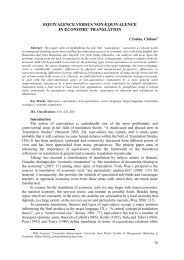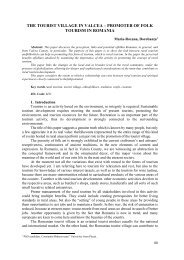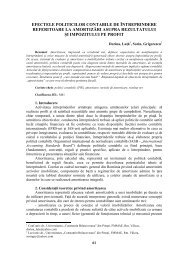Revista PDF - strategiimanageriale.ro
Revista PDF - strategiimanageriale.ro
Revista PDF - strategiimanageriale.ro
Create successful ePaper yourself
Turn your PDF publications into a flip-book with our unique Google optimized e-Paper software.
For long periods of time marketers have analysed how some brands acquire a “soul”,<br />
a “voice”, a “personality”, so they realized that Apple has its own “cult”, Nike has its own<br />
“tribe”, Coca-Cola has “enthusiastic members” etc. It has become increasingly clear that<br />
the future of those brands will be to sur<strong>ro</strong>und the community of loyal customers that<br />
encourage them to consume faster and more depending on technological developments,<br />
pricing strategies or even p<strong>ro</strong>duct range renewal. This is easily possible in the cases of<br />
already famous companies, which have created and developed members communities and<br />
a system of trust f<strong>ro</strong>m them, but for other bidders it is a challenge that can determine<br />
success or failure in the years to come.<br />
Relating to this system of trust that is developed by the brands for their community<br />
members a set of specific components has been formed: brand creation story, creed, icons,<br />
rituals, sacred words, unbelievers and the leader. When these components are highlighted,<br />
consumers are attracted to the brand, helping to create a relevant, active community.<br />
(Hanlon, 2007):<br />
- the story of the brand creation is, in fact, its legend (e.g. Google was born in a<br />
bed<strong>ro</strong>om, Apple and Hewlett-Packard in a garage, Starbucks started in a flower shop in<br />
Seattle, Nike appeared when its founder began selling shoes in the trunk of the car, etc.);<br />
- the creed brand is the idea that consumers retain and the image makers have<br />
synthesised in a few words regarding to the business philosophy; there is the central<br />
element that attracts the people to whom a certain brand wants to share its beliefs (e.g.<br />
“Ultimate driving machine”, “A green planet”, etc.);<br />
- the icon establishes a visual tag that extends beyond the p<strong>ro</strong>duct itself and allows<br />
community members to identify it (e.g. Sydney Opera House, Statue of Liberty, Eiffel<br />
Tower etc.);<br />
- the ritual is composed of things that community members want to do together, there<br />
are life models, daily activities networks that connect people (e.g. marathons, café<br />
discussions, beer festivals, winter carnivals, etc.);<br />
- the sacred words composing the community’s vocabulary th<strong>ro</strong>ugh which the<br />
persons belonging or not to that g<strong>ro</strong>up are identified; regardless of their p<strong>ro</strong>fession, to<br />
belong to the community, these words must be known;<br />
- the unbelievers appear as a countertrend, and while marketing helps us to identify<br />
characteristics of customers, there will always be people who will fall within this<br />
description; this situation creates, however, certain opportunity (e.g. consumers not using<br />
p<strong>ro</strong>ducts that contain sugar, drinking decaffeinated coffee, etc.);<br />
- the leader is found in the person who exceeds all the difficulties and recreates a<br />
certain state of affairs in accordance with its terms (e.g. Bill Gates, Oprah Winfreys – at<br />
the mac<strong>ro</strong> level, and p<strong>ro</strong>ject leaders, team leaders, supervisors – at mic<strong>ro</strong> level, etc.).<br />
When all the pieces of this code work together a st<strong>ro</strong>ng attraction to the brand can be<br />
created, but each element is a point of differentiation that give the individual the<br />
opportunity to create a system of beliefs which brings him/her near those who already<br />
share them, giving the community a sense of existence. Moreover, by creating consumers<br />
who make recommendations to others about the brand of that community, it is possible to<br />
reach their long-term maintenance.<br />
In other words, brands need to communicate what is interesting for the community<br />
members, with the advantage that they can always ask for feedback in a competition,<br />
inviting them to events, organizing face-to-face meetings on topics of interest, giving them<br />
information about the organization and those who compose it, using photo and video<br />
content and putting them in the spotlight. Inside these initiatives a focus-g<strong>ro</strong>up system can<br />
be organized with the members of the brand community, in terms of reduced costs and to<br />
obtain information about consumption preferences and motivations, competition, etc.<br />
40







